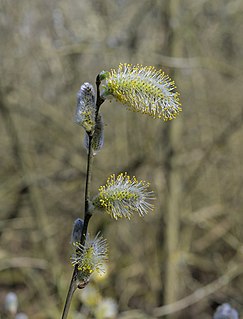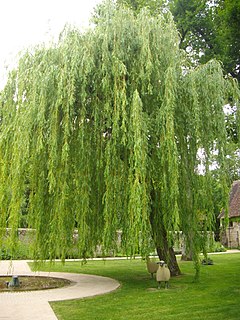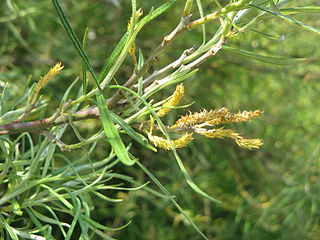
Willows, also called sallows and osiers, from the genus Salix, are around 400 species of deciduous trees and shrubs, found primarily on moist soils in cold and temperate regions of the Northern Hemisphere.

Salix caprea, known as goat willow, pussy willow or great sallow, is a common species of willow native to Europe and western and central Asia.

Salix × fragilis, with the common names crack willow and brittle willow, is a hybrid species of willow native to Europe and Western Asia. It is native to riparian habitats, usually found growing beside rivers and streams, and in marshes and water meadow channels. It is a hybrid between Salix euxina and Salix alba, and is very variable, with forms linking both parents.

Salix babylonica is a species of willow native to dry areas of northern China, but cultivated for millennia elsewhere in Asia, being traded along the Silk Road to southwest Asia and Europe.

Larix gmelinii, the Dahurian larch or Gmelin larch, is a species of larch native to eastern Siberia and adjacent northeastern Mongolia, northeastern China (Heilongjiang), South Korea and North Korea.

Salix nigra, the black willow, is a species of willow native to eastern North America, from New Brunswick and southern Ontario west to Minnesota, and south to northern Florida and Texas.

Salix myrsinifolia, known as the dark-leaved willow or myrsine-leaved willow, is a species of willow native to Europe and Western Siberia. It forms a 2–5 m (6.6–16.4 ft) high shrub. In the north it often becomes a tree up to 8 m (26 ft) tall.
Larix gmelinii var. olgensis, synonym Larix olgensis, the Olga Bay larch or Olgan larch, is a variety of larch. The variety is named after Olga Bay in the Sea of Japan. The common name in Japanese language is 満洲唐松. The common name in Chinese is 黄花落叶松. This variety occurs in Central Sikhote-Alin, and rarely occurs in North Korea, and Jilin and eastern Heilongjiang provinces of China, between 500 and 1100 metres in elevation.

Ranunculus gmelinii, Gmelin's buttercup or small yellow water-crowfoot, is a species of flowering plant in the buttercup family, Ranunculaceae. It is native to northern North America, where it occurs across Canada and the northern and higher-elevation regions of the United States. It is also present in Eurasia.

Larix gmelinii var. principis-rupprechtii, synonym Larix principis-rupprechtii, Prince Rupprecht's larch, is a variety of conifer in the genus Larix. It is native to the mountainous regions of the Shanxi and Hebei provinces of northern China.

Salix humboldtiana, called Humboldt's willow, is a tree species of willow native to North and South America, growing along watercourses. Some authorities consider it a synonym of Salix chilensis, which Molina described in 1782. Willdenow described Salix humboldtiana in 1805.

Salix repens, the creeping willow, is a small, shrubby species of willow in the family Salicaceae, growing up to 1.5 metres in height. Found amongst sand dunes and heathlands, it is a polymorphic species, with a wide range of variants. In the UK, at least, these range from small, prostrate, hairless plants at one end of the spectrum to taller, erect or ascending silky-leaved shrubs at the other. This wide variation in form has resulted in numerous synonyms.

Salix pedicellata is a species of willow. It is a shrub or small tree to about 6–8 m tall, native around the Mediterranean Sea from Portugal to Lebanon and Syria in the north and from the Canary Islands to Tunisia in the south. Salix canariensis may be treated as a subspecies of S. pedicellata.
Salix chilensis, the Chilean pencil willow, is a species of willow native to Mexico, Central America and South America, described by Molina in 1782. Some authorities consider it conspecific with Salix humboldtiana, which Willdenow described in 1805.
Betula gmelinii is a species of birch native to the Altai, Siberia, Mongolia, northeastern China, the Korean peninsula and Hokkaido in Japan. It prefers to live in sandy soils. Its 'Mount Apoi' cultivar has gained the Royal Horticultural Society's Award of Garden Merit.

Alyssum montanum is a species of flowering plant belonging to the family Brassicaceae. It is an evergreen, prostrate perennial with small, hairy, greyish leaves. It typically grows to 10-15 centimeters tall and 30-45 centimeters across. It produces tiny, yellow, fragrant flowers from May to July. These flowers are typically 4-6 centimeters across and borne in dense racemes.

Salix rosmarinifolia is a species of flowering plant belonging to the family Salicaceae.
Salix myrsinites is a species of flowering plant belonging to the family Salicaceae.

Salix euxina, the eastern crack-willow, is a species of flowering plant in the willow family Salicaceae, native from Turkey to the Caucasus. It was first described by I. V. Belyaeva in 2009. It is one of the parents of the common crack-willow, Salix × fragilis.















